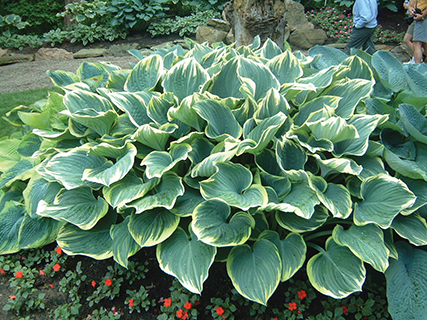HOSTA
Hosta–still king of shade plants and easy for every gardener to grow
Why Hostas
Hostas continue to reign as the king of shade plants. In fact, they remain the top selling perennial in the country, surpassing the ever-popular daylily by a factor of two in sales volume. Hostas tolerate shade where many plants do not. But why are hostas so popular? How many of you grow a perennial for that 2 week period where you can enjoy the flower blooms, and then simply tolerate the plant the rest of the season? With hostas it’s just the opposite. You can tolerate the flowers for 2 weeks (although even that is changing), but you get to enjoy fabulous foliage the entire growing season. Imagine a range of hosta sizes from a single leaf measuring 1” across to a giant measuring 28” across; clump sizes ranging from 6” tall minis to 50” tall giants that may spread up to 10 feet; leaf shapes ranging from very narrow and elongated, to completely round; foliage colors of solid green, yellow and blue, and then adding white and cream for variegated combinations; and flowers that are fragrant with many cultivars. And, if that isn’t enough, the latest in hostas – red and orange colored leaves and red and yellow flowers – add even more options.
 Among the 7000 or so named cultivars there is a hosta for every location in your garden. In recent years, the most popular hosta selections have gone to the two extremes – mini and giants. What ‘Blue Mouse Ears’ did for the world of mini hostas, ‘Empress Wu’ has done for the world of giant hostas. New to hostas? Not a problem. Visit our website for the top 25 most popular hostas as voted annually by the American Hosta Society membership. These are all easy to grow and perform well across the country. The top two in popularity – ‘June’ and ‘Sagae’ – have remained in the number 1 and 2 slots for many years for good reason.
Among the 7000 or so named cultivars there is a hosta for every location in your garden. In recent years, the most popular hosta selections have gone to the two extremes – mini and giants. What ‘Blue Mouse Ears’ did for the world of mini hostas, ‘Empress Wu’ has done for the world of giant hostas. New to hostas? Not a problem. Visit our website for the top 25 most popular hostas as voted annually by the American Hosta Society membership. These are all easy to grow and perform well across the country. The top two in popularity – ‘June’ and ‘Sagae’ – have remained in the number 1 and 2 slots for many years for good reason.
Keys to Hosta Success –
location, soil prep and
water, water, water
In the overall plant kingdom, hostas are easy for every gardener to grow and enjoy. It is important to stress that, while they tolerate shade, they prefer more light than most realize. For optimum growth locate your hosta where they will get some morning sun and then are shaded from the hot afternoon sun. While solid green and blue colored hostas will perform well in full shade, variegated cultivars especially those with a substantial amount of white in the leaf really need some morning sun to survive. And gold or yellow hostas will always be a brighter color with some morning sun.
Besides planting location, the two keys to success for growing hostas in KC are good soil prep and adequate moisture. Unlike many perennials, hosta never need to be divided so good soil prep in advance of planting will pay huge dividends for years to come. Hostas like plenty of moisture, but not wet feet. Good drainage is the key. Our typical native clay soil holds moisture, but doesn’t drain well. That’s where organic matter (compost, sphagnum, etc.) is the key. Be liberal in incorporating organic matter into your beds.
While rain has been plentiful this spring, we will most likely be praying for rain in another month or so. Hostas like 1 to 1.5 inches of water per week during the growing season. When July and August brings the invariably hot and dry weather, get out the hose to provide the additional moisture. Hostas rarely wilt and don’t give us the warning sign that they need water. Unfortunately, we don’t see the effect until the following spring when they emerge smaller, not larger.
While fertilizer can push growth, fertilizing in the spring can be counterproductive if hosta are not watered well during the summer. If you do opt to fertilize, make a commitment to water all summer long to support the additional growth.
Rob Mortko, along with his wife Sheri, own and operate Made in the Shade Gardens specializing in hostas and located in Olathe, KS. Visit their website at www.HostaGuy.com.
To view additional images of Hosta, visit the online version of the June 2017 issue at KCGMAG.com.
